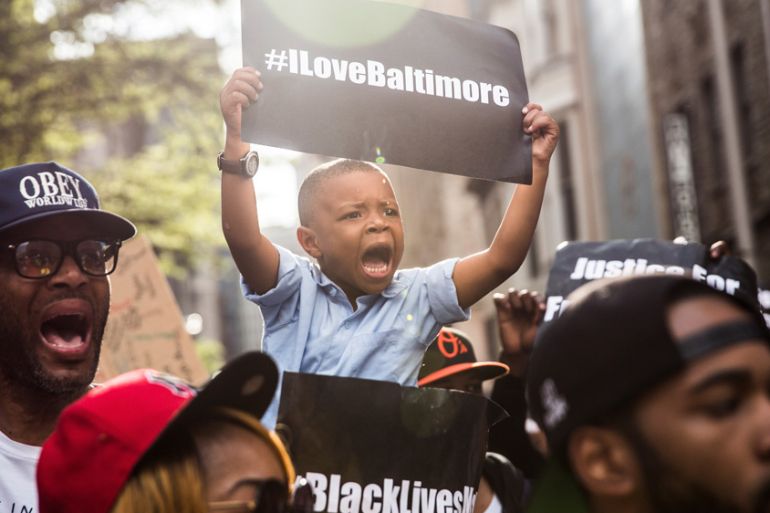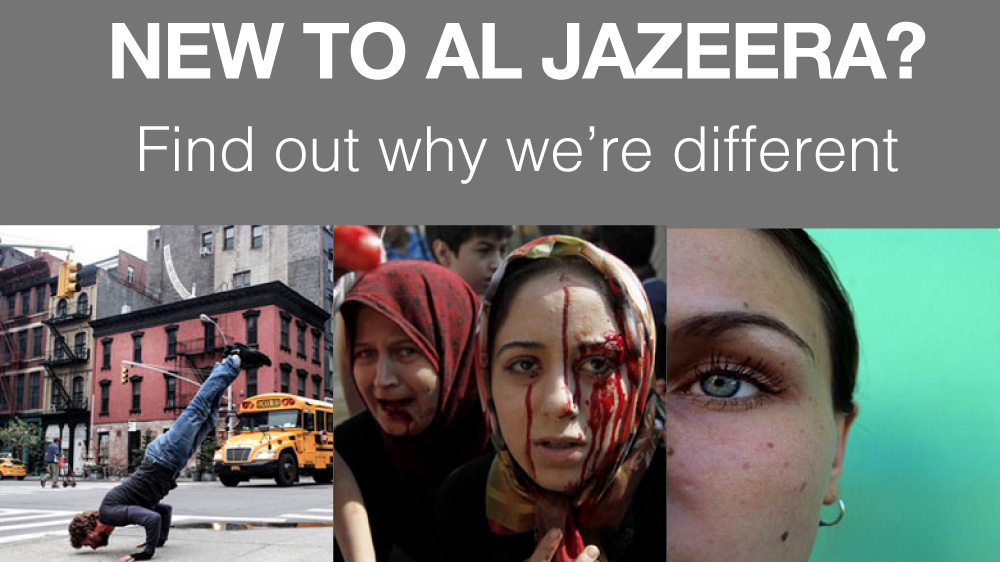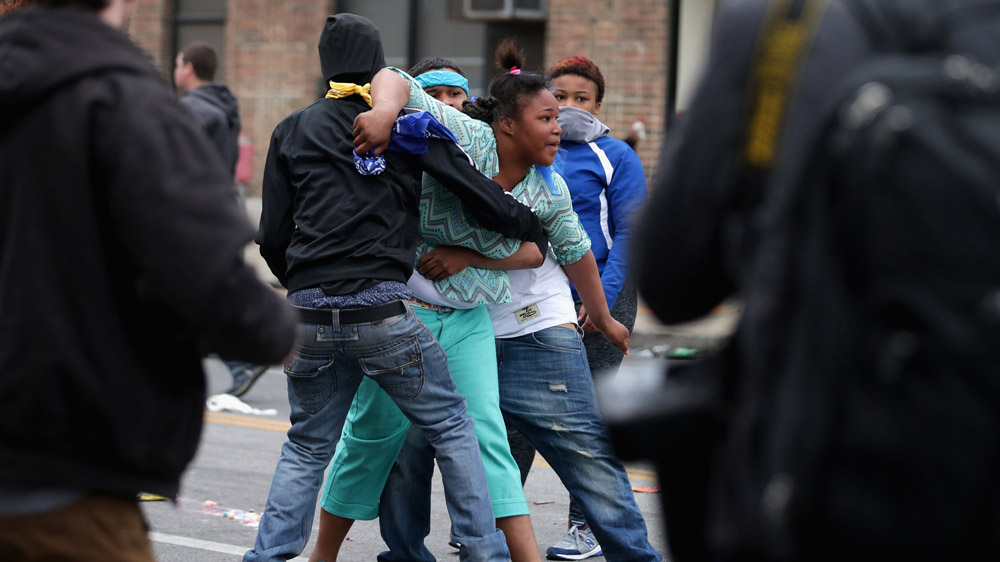Magazine: Black Panther cub on new era of civil action
In the year since the death of Michael Brown, black Americans have brought civil disobedience into the 21st century.

What I remember most viscerally is the fear.
It had been almost four hours, and I couldn’t get the handcuffs off. The lights in the underground subway station were flickering, and I had an almost phobic fear of the dark. The white cop who had cuffed me to the gate inside the subway station was gone, and I didn’t know when he was coming back. He did return, sometime later, letting me go with a lecture and a hefty fine I had no way of paying. I had peed on myself. I was 11 years old.

It wasn’t the first time I had been illegally detained by a police officer. In fact, in the US, arbitrary detention is one of the most common ways for police officers to initiate contact with black people of all ages. The overbroad nature of the law, and the subjectivity of those who enforce it, supports judgment calls by police, despite the fact that they consistently choose to be more brutal than is necessary in the act of subduing the black body.
Keep reading
list of 4 itemsA year of survival in the Turkey-Syria earthquake zoneThis article will be opened in a new browser window
‘If I die, I die’: The allure of Pakistan’s death-trap route to Europe
Lojay, the preacher’s son minting romantic anthems from stripper therapy
I think of that night often, especially these days, when the photograph of Tamir Rice, the 12-year-old child gunned down by police in Cleveland, Ohio, stares back at me. I think that, no matter how young we are, we are perceived to be something other than children.
Watch: A year after Ferguson: Residents remember Brown’s death
Perhaps the perpetual dehumanisation of those formerly enslaved by those privileged by slavery is the only possible outcome of a nation that built its wealth on chattel slavery – especially if, as in the United States, black labour is still violently extracted for pennies on the dollar – in domestic work, fast food chains, restaurants, big box stores, and elsewhere.
I think of that night because it is one more example of how being black and breathing in America is a victory unto itself.
Once a Panther, always a Panther … even when you’re just a cub
![Protests against the incarceration of members of the Black Panthers in New York on November 17, 1969 [David Fenton/Getty Images]](/wp-content/uploads/2015/08/6777ffe17e724115be9cd689b82c8306_18.jpeg)
My mother was a member of the Black Panther Party. My father, absent though he was, was a member of the Black Liberation Army. My aunties and uncles were my mother’s comrades. And all of us children were their cubs.
Being a Panther cub meant that, in the late 1970s, when Haitian people were attempting to flee the violent repressive rule of Haitian president Jean ‘Baby Doc’ Duvalier, my mother took me to protest against the United States’ treatment of these migrants. She hoisted me up onto her shoulders, and I shouted with all the vigour my five-year-old lungs could muster, “Let them stay.”
The poem I wrote about it still sits, folded neatly between my mother’s newspaper clippings from that time. It was streaked with the tears I shed after hearing the stories of capsized boats and dead children trying to travel the 700 miles between Haiti and Florida.
Being a Panther cub meant that on June 20, 1990, I was one of thousands who packed themselves so closely together in the dogged field surrounding Boys and Girls High School in Brooklyn, New York, that there was barely room for breath. The excitement was visceral, we hardly noticed the smattering of white faces salting the crowd. We were as blackbirds, cooing our excitement, calling our joy up to the sky with shouts of “Right on”, “Black is beautiful”, and “Black Power” as we waited, breathless, for Nelson Mandela, the infamous South African freedom fighter, to take the stage.
My mother died a week after the FBI visited our home. I was afraid all the time.
![A Black Panther Party parade in downtown Boston in 1970 [Spencer Grant/Getty Images]](/wp-content/uploads/2015/08/1d1f49af64674a1eb1ea28f526372428_18.jpeg)
Had I been alive during the 1955 Montgomery Bus Boycott, or in 1963 during the non-violent marches in Birmingham, Alabama; had I witnessed the rise of the Student Non-Violent Coordinating Committee (SNCC), watched when Dr King and Malcolm X were assassinated, or participated in the rise of the Black Panther Party in the late 1960s, I might have understood that, for a people emerged from American chattel slavery to sharecropping, to the industrialisation of a manufacturing economy that all but bled their labour dry, a deep knowledge of one’s own humanity was a pre-requisite to speak the words “Black Power” aloud.
Instead, my teenage years were lived at the end of a decade of death and the beginning of a decade of mass incarceration. My childhood was spent sandwiched between two wars, Aids and crack, both of which seemed to deliberately and systemically ravage black bodies, first and worse.
Instead, I watched as some of the most vibrant national civil rights organisations began to become part of an existing status quo. Instead, I came out as a black lesbian into a decade that hated me, into a movement so narrowed by cultural nationalism and class divides that it had dashikis but no demands.
I left New York and moved to California, searching for a movement.
Like many thousands of black activists, I waded through the multicultural waters of the last 20 years. Even as black organisers and activists actively built a solidarity movement with other communities of colour, anti-blackness prevailed without an organised counter.
Until now.
Before my mother joined the Panther Party, she joined SNCC. It had emerged from a student meeting organised by Ella Baker and subsequently escalated the tactics of the Civil Rights Movement from lunch counter sit-ins and boycotts to an era of black direct action opposing segregation and white vigilante violence in the American South and throughout the United States. It was this energy and agency that brought us the Freedom Rides, Freedom Summer and the birth of the Black Panther Party in 1966. It is this political moment that radicalised my mother and motivated her to become a leader in the New York Chapter of the Black Panther Party.
We are in a similar moment of black radicalisation today, one in which self-organised groups of black millennials will – with deft, precise and coordinated direct action tactics – shape a narrative on race and power that, in the process of uplifting black lives, will improve conditions for everyone.
From the 1970s ‘culture of poverty’ theories to the mass criminalisation of black communities in the 1980s and 1990s, black people have long been the subjects or objects of debate. This moment of direct action, however, rejects the forcible control of black racial identity, political power and economic position through biased and brutal policing. Instead, it casts black people as the leading protagonists in a story about race, power and resistance where we are both character and author.
We’re bringing Black direct action back

By almost any indicator, black people in America remain disadvantaged, despite the election of a black president. According to the Guardian, 42 percent of black children are educated in high-poverty schools. The unemployment rate for black high school dropouts is 47 percent versus 26 percent for white high school dropouts. Although black people make up just 13.2 percent of the US population, they account for 37 percent of the homeless.
One in every 13 African Americans of voting age is disenfranchised because of a felony conviction – a rate more than four times greater than the rest of the US population. In fact, African Americans now constitute nearly one million of the total 2.3 million jail population and black men are around six times as likely to be incarcerated as white men.
Despite heightened levels of repression since the 1960s, black communities have decided that we will resist, even if we are afraid of the patriarchy and homophobia that weaken every movement for justice across the globe. Or the myth that only a talented elite can lead, and the gatekeeping organisations that belief has given rise to. Or the many mechanisms this country has developed to isolate and deter organising – including a growing right wing movement – that has rolled back the gains of the Civil Rights Movement, one legislative act at a time.
From the recent gutting of the 1965 Voting Rights Act, to the re-segregation of American schools in defiance of Brown vs. Board of Education, what the Civil Rights Movement won is being taken apart.
At the same time, a racial wealth gap is growing, with those at the bottom powering those at the top. This codification of hierarchy reminds me of something my mother always used to say, “You only need force if people think it’s wrong”.
Luckily, more and more people think it’s wrong that the US is the world’s leader in incarceration, with around 2.3 million currently in the nation’s prisons or jails, and more than nine million in the custody or control of the American judicial system. More than 60 percent of those are racial and ethnic minorities, with racial disparities littered all through the judicial process.
The right didn’t simply dismantle black infrastructure, movements and civil rights legislation. Their policies, their contract on America, took a metaphoric ‘hit’ out on black lives – leaving Panther cubs like me to fend for ourselves politically in a period of demoralisation, state militarisation and economic deregulation that hit black communities like a tonne of bricks.
We put our bodies on the line
![Thousands march to call for an end to police brutality and justice for those who have lost loved ones at the hands of police and law enforcement during the National March on Washington led by Al Sharpton and the National Action Network in Washington, DC on December 13, 2014 [Marvin Joseph/The Washington Post via Getty Images]](/wp-content/uploads/2015/08/fe1967cdc0624fe1a8e35d99c7608cdb_18.jpeg)
Perhaps that is why, 25 years later, the Movement for Black Lives has been birthed into being by a thousand leaders instead of one.
Perhaps that is why the Movement for Black Lives refuses to hot box the stale smoke of narrow cultural nationalism, and instead embraces an intersectional approach that seeks a new nation where all Black Lives Matter.
Though one can never truly quantify the tipping point for the swelling of unrest into rebellion, one theory that answers the question ‘why now’, is the emergence of digital technologies. Although there is peril in the emergence of technologies like police body-worn cameras that collect data indiscriminately in violation of our fourth amendment rights, there is also promise in the use of video – both from body cameras and bystanders – to record the illegal and violent behaviour of the police, which has, for decades, been ignored and hidden by those in power.
It’s harder to hide murder by cop when you are recorded on the cell phones of bystanders everywhere.
And these actions are making a huge impact.
At 7:30am on a rainy Monday morning, a multi-racial team of activists led by black millennial direct action groups Blackout Collective and Black Lives Matter accomplished what had never been done before. They shut down police headquarters in downtown Oakland, California, for four hours and 28 minutes.
Four hours, they said, to represent the length of time the dead body of unarmed black teenager Michael Brown lay in the street after he was shot by a white police officer, Darren Wilson; 28 minutes to signify the fact that a black man, woman or child is killed by police or vigilantes every 28 hours, according to a 2012 study called Operation Ghetto Storm conducted by the Malcolm X Grassroots Movement.
In Oakland, Black Lives Matter activists locked down the West Oakland BART (Bay Area Rapid Transit) Station on Black Friday. A week later, the #BlackBrunch team marched into crowded restaurants in Oakland’s majority-white Rockridge neighbourhood, where they recited the names of black people killed by police, their voices rising over the clank of dishes and the stunned silence of families out to brunch.
Collectives of young black leaders have led marches to the courthouse steps and raised fists in front of the police department, sending images of black resistance bouncing across the globe. In just 12 action-packed months, black millennials have brought black civil disobedience into the 21st century, and their demands are as visionary as their actions.
This amazing display of strategic coordination and tactical discipline represents a new era of social protest methodology that seeks cultural as well as political and economic change. These leaders refuse to cooperate with the business of anti-black racism as usual. Armed with protest songs and a shared vision, backed by allies across the lines of race and age, and communicating on multi-directional digital platforms, a new generation of black activism is being born.
In this new era, while demands are being leveraged at the federal level, action is taking place at home, where black bodies continue to stack up, and police officers, security guards and vigilantes – most often white – take comfort, and even gloat, in their impunity.
We have nothing to lose but our chains
![Mike Jones of Oakland holds a shirt reading 'Don't shoot' during a 'Millions March' demonstration protesting against the killing of unarmed black men by police on December 13, 2014 in Oakland, California. The march was one of many held nationwide [Elijah Nouvelage/Getty Images]](/wp-content/uploads/2015/08/e5c52407403f4e9e914da7cb93b84f06_18.jpeg)
Sometimes I forget.
I forget that citizenship isn’t just what they tell me it is. I forget that since Europeans first landed on what is now known as the Americas, stripped the indigenous people of land, language and nation, and codified a system of chattel slavery as a core and first form of American currency – the question of who can be a citizen of the United States and who is cast outside of the privileges of statehood has been an ongoing conflict.
My neighbours were sick, and instead of receiving care, they were receiving jail sentences for possession of small amounts of drugs.
My mother was sick, too. And instead of receiving care, she got morphine.
My mother – the memory of her small, fragile body is a constant reminder that citizenship is not a privilege, though there are those who will treat it as such. Privileges are not deserved and can be taken from you. The kind of belonging upon which basic rights are predicated must itself be a basic right.
That is why the Movement for Black Lives isn’t merely a Civil Rights Movement. It is the movement Malcolm and Martin and Ella Baker and hundreds of other freedom fighters were moving towards. It is a Human Rights Movement, and it is using all the technology at its disposal, and an open Internet protected by net neutrality, to win.
When my mother was a child, it was illegal for white people and black people to drink from the same water fountains or go to the same schools. Today, desegregation and voting laws remain aspirational, and require that a movement do more than demand legislation, we must change hearts and minds.
In a digital age, with decentralised leadership, and powerful demands, I think the Movement for Black Lives might set the world in the visionary direction it can walk for the next century. Or two.
My mother won’t be here to see it, and perhaps I won’t be either. But we’re moving. And I believe we can win. After all, what do we have to lose?
Malkia Cyril is the founder and executive director of the Center for Media Justice and co-founder of the Media Action Grassroots Network. For more than 20 years she has worked with hundreds of leaders of colour to strengthen their communities and campaign strategies. In addition to being a published writer, Malkia is a Black Panther cub, and a member of Black Lives Matter Bay Area.
The views expressed in this article are the author’s own and do not necessarily reflect Al Jazeera’s editorial policy.
This article will appear in the upcoming August issue of the Al Jazeera Magazine, A journey through race in the US. Download it here for iPads and iPhones and here for Android devices.